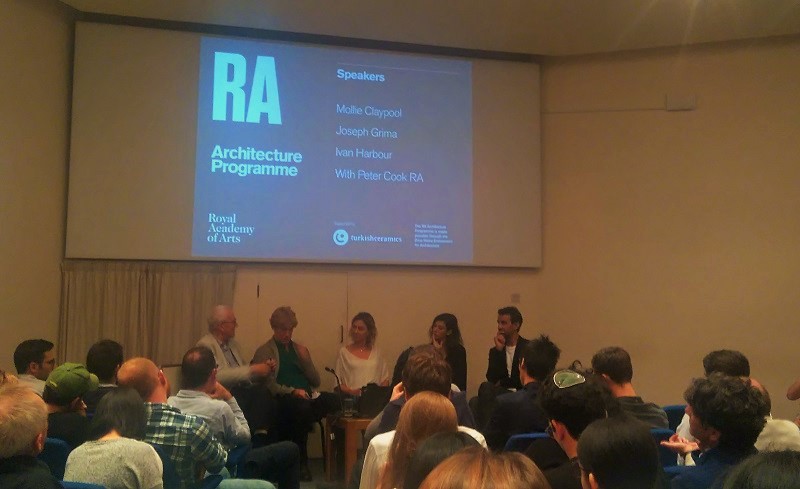Main author
Michael BrooksPlug-In to Housing
On 5th September 2016, Designing Buildings Wiki attended the Royal Academy for a panel discussion about ‘Plug-In to Housing’. The event was part of the Academy’s ‘Peter Cook RA: Floating Ideas’ programme.
As part of the esteemed panel, Peter Cook RA – one of the founding members of the radical Archigram group – began by explaining the themes and ideas that inspired his legendary ‘Plug-In City’ project in 1964.
‘Plug-In City’ proposed a constantly evolving megastructure that incorporated housing, transportation and other services. Modular residential units that interlocked with an infrastructural core could be moved by cranes, responding to the dynamic conditions of the city and its inhabitants. Like other Archigram projects, this concept championed collective living and presented architecture not as isolated buildings but part of a connected system. Theory and innovation aside though, Cook affirmed his ethos that “in the end, the home is more important than the housing”.
The panel addressed the issue of what the speculative ideas and bold aspirations of ‘Plug-In City’ could offer contemporary society as it struggles to adequately house its own citizens, and each came at the idea of ‘housing’ from different innovative angles.
Ivan Harbour, architect and senior partner at Rogers Stirk Harbour + Partners (RSHP), began by suggesting that alternative methods of building are vital as they might provide a cost-effective way of making construction achievable. He described an unrealised Korean housing project near docks that used shipping containers as housing units. The idea was that the units would be placed around a flexible core by computer control, allowing for minimal human agency and improved efficiency.
This concept fed into RSHP’s later Y:Cube developments; affordable housing units designed as ‘move-on accommodation’ for single people leaving homelessness hostels and supported housing schemes. One of the advantages of these units, Harbour said, was a substantial cost saving in project management.
Y:Cube uses a pre-constructed modular system that enables units to stack on top or alongside each other, making it adaptable to the size and space available and well-suited to tight urban sites. Each unit is constructed from high-quality, environmentally-efficient materials (mainly renewable timber), creating accommodation that requires little or no heating, even in the winter.
Harbour also explained how RSHP were working with Medecins du Monde to try and develop a medical facility using elements that can be assembled by the users themselves rather than machines.
Mollie Claypool, designer, writer and educator at the Bartlett and AA School, spoke about her research into architecture that is wholly digital, with an emphasis on design methods for fabrication and assembly units, in connection to housing. This was, she said, a fundamental shift in the way digital designers deal with architecture, offering the potential to have a better dialogue with policy makers, users and building design and construction.
It was her aim, she said, to strip digital design back to basics, or ‘discreteness’, being able to understand a building only through its connections and joints, which could be re-imagined as ‘digital materials’.
She described digital materials as being similar to Lego pieces with ‘male-female’ connections, or binary 0-1 in terms of computer code. There are many aggregations and combinations of a single building part, which can be used to interact with a whole range of different elements in a building. The potential was there to deal, not only with material and structural redundancy, but with spatial redundancy as well.
Joseph Grima, architect, writer/researcher and founder of Space Caviar, spoke about the frequent frustrations in how housing is addressed – either in purely technological, economical or prefabrication terms. He stressed the importance of understanding the home from all perspectives, as something that defies all reduction into simple terms.
He expressed his interpretation of Cook’s ‘Plug-In City’ as being, not just an influential aesthetic, but an allusion to the technologically-saturated society of the time. He drew upon analysis of rising land prices across western societies over the last 30-40 years, to explore the idea that space cannot be defined in spatial terms any longer but as a form of currency that has value as part of a market, with all kinds of cascading consequences.
Related to this, there is no longer any distinction between space of labour and space of domesticity, as what makes up ‘the home’ is no longer simply defined. As evidence of this he pointed to the likes of AirBnb, smart refrigerators and thermostats, or the habit of working from smartphones and iPads at home. He mentioned a recent survey in which it was found that 40% of Londoners said they did work before going to work.
Grima pointed to a project he had led called RAM House which looked at the idea of data as a form of oil, being extracted from the home. Analysis and interpretation of this data would, he said, place control back in the hands of the homeowner.
[edit] Related articles on Designing Buildings Wiki
Featured articles and news
International Electrician Day, 10 June 2025
Celebrating the role of electrical engineers from André-Marie Amperè, today and for the future.
New guide for clients launched at Houses of Parliament
'There has never been a more important time for clients to step up and ...ask the right questions'
The impact of recycled slate tiles
Innovation across the decades.
EPC changes for existing buildings
Changes and their context as the new RdSAP methodology comes into use from 15 June.
Skills England publishes Sector skills needs assessments
Priority areas relating to the built environment highlighted and described in brief.
BSRIA HVAC Market Watch - May 2025 Edition
Heat Pump Market Outlook: Policy, Performance & Refrigerant Trends for 2025–2028.
Committing to EDI in construction with CIOB
Built Environment professional bodies deepen commitment to EDI with two new signatories: CIAT and CICES.
Government Grenfell progress report at a glance
Line by line recomendation overview, with links to more details.
An engaging and lively review of his professional life.
Sustainable heating for listed buildings
A problem that needs to be approached intelligently.
50th Golden anniversary ECA Edmundson apprentice award
Deadline for entries has been extended to Friday 27 June, so don't miss out!
CIAT at the London Festival of Architecture
Designing for Everyone: Breaking Barriers in Inclusive Architecture.
Mixed reactions to apprenticeship and skills reform 2025
A 'welcome shift' for some and a 'backwards step' for others.
Licensing construction in the UK
As the latest report and proposal to licence builders reaches Parliament.
Building Safety Alliance golden thread guidance
Extensive excel checklist of information with guidance document freely accessible.
Fair Payment Code and other payment initiatives
For fair and late payments, need to work together to add value.
Pre-planning delivery programmes and delay penalties
Proposed for housebuilders in government reform: Speeding Up Build Out.
High street health: converting a building for healthcare uses
The benefits of health centres acting as new anchor sites in the high street.


























